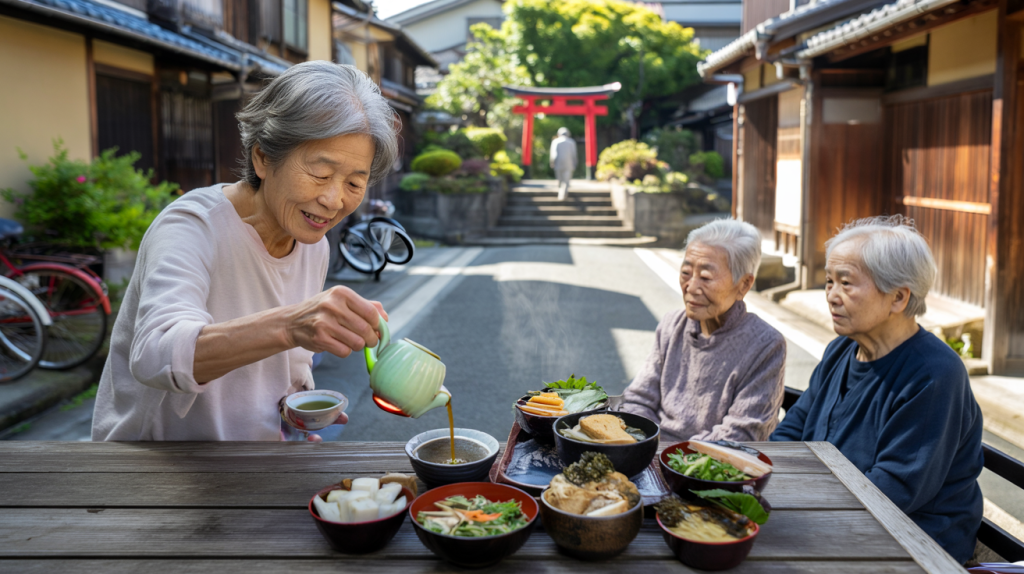Meta description : Japan leads global longevity. Discover ikigai, hara hachi bu, tea rituals and social ties, with studies and simple steps to try today.
Japan keeps topping the longevity charts. The World Bank reported an average life expectancy near 84 to 85 years in 2019, among the highest anywhere. The country also counted 92,139 centenarians in 2023, according to Japan’s Ministry of Health, Labour and Welfare, with women making up almost nine in ten. The question lands fast : what do daily routines there get right that many of us miss.
There is no miracle berry. The secret reads more like a quiet stack of frictions and supports. Think plant rich bowls, a habit of stopping at 80 percent full called hara hachi bu, a reason to get up in the morning known as ikigai, and social circles that do not let anyone drift alone. Small moves, repeated for decades, add up.
Japanese longevity basics : diet, routine, mindset
The main idea is simple. Long life in Japan grows from ordinary choices repeated many times. The observation is everywhere, from Okinawa to urban neighborhoods. Meals lean on vegetables, legumes, tofu, seaweed, fish in modest portions. Movement hides in plain sight through walking, stairs, gardening. Community stays close.
Where many struggle is not knowledge but friction. Big plates invite big portions. All day sitting drains energy. Stress piles up and sleep slips. The problem can be solved by trimming the default, not chasing extremes.
Here is the short list people search for when looking up Japanese longevity. It is not magic. It is consistent.
- Hara hachi bu : stop eating when about 80 percent full to avoid habitual overeating
- Plant forward meals : vegetables, soy foods like tofu and miso, seaweed, mushrooms, plus small fish
- Green tea breaks : several cups across the day instead of sugary drinks
- Ikigai : a clear purpose or role that anchors the day
- Moai style ties : tight social circles that check in and share small burdens
Evidence that keeps showing up : ikigai, tea, and social ties
Data backs the pattern. A large Japanese cohort, the Ohsaki Study, followed adults for years and reported in 2008 that those who said they had ikigai faced a lower risk of death. The adjusted hazard ratio was 0.85, which points to roughly a 15 percent lower mortality risk over seven years for people reporting a sense of purpose (Ohsaki Study, 2008). Source : PubMed.
Tea time is not just ritual. In 2006, researchers tracking more than 40,000 Japanese adults found that drinking five or more cups of green tea per day was associated with lower all cause mortality compared with those drinking less than one cup. The reduction was about 23 percent in women and 12 percent in men over an eleven year follow up (Ohsaki National Health Insurance Cohort, 2006). Source : The New England Journal of Medicine.
Connections matter too. A well known meta analysis published in 2010 found stronger social relationships were associated with a 50 percent higher odds of survival across diverse settings. It is not a Japan only result, yet it fits the moai tradition of lifelong mutual support. Source : PLOS Medicine, 2010.
Zooming out, the country’s longevity context stands clear. The World Bank listed Japan’s life expectancy at 84.7 years in 2019, a level that keeps it at or near the top globally. Source : World Bank Data. And on Respect for the Aged Day in 2023, the Ministry of Health, Labour and Welfare confirmed 92,139 centenarians nationwide, up for the 53rd straight year. Source : MHLW.
Turn big ideas into tiny moves that stick
People do not need a new identity. They need one small behaviour that survives a busy week. Start with the plate. Switch to smaller bowls for rice and noodles. Add one extra vegetable at lunch. Pause for a breath before second helpings to check the 80 percent signal.
Tea helps because it replaces something. Brew a pot in the morning and pour into a bottle for the day. That single swap pushes out one sugary drink without effort. The 2006 findings cited above suggest a practical dose without chasing perfection.
Ikigai sounds abstract until tied to a role. A weekly promise to pick up a grandchild, tend a community garden, or teach a neighbor a simple skill creates structure. The Ohsaki data did not ask for grand passions, only a felt purpose.
And movement. Not workouts with a stopwatch. More stairs, short walks after dinner, a standing call with a friend. The goal is to make sitting feel slightly inconvenient.
The missing piece most guides skip : environment by design
Japanese longevity sits inside a supportive environment. Portions run smaller at home and in many restaurants, streets invite walking, public transport builds steps into the day, social rituals check on elders. That scaffolding keeps habits on track even when motivation dips.
So copy the scaffolding. Place fruit where it is seen, not hidden. Keep tea leaves and a kettle within reach. Use smaller plates by default. Add recurring calendar invites that lock in human contact. Create friction where it helps, like storing snacks out of sight or a bit farther away.
The logic is consistent with the evidence. Purpose lowers risk over years. Tea routines correlate with better survival. Strong ties boost odds of living longer. Repeated together, these small, almost boring choices compound. It feels definetly less glamorous than a miracle fix. Yet it is exactly how Japan quietly extends life, one ordinary day at a time.
